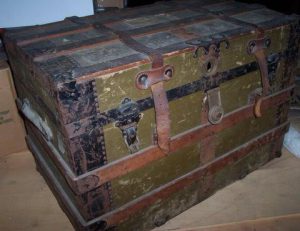 Facts can be so unsatisfying. Colorless (but critical) records of lives, people, places, and events, when facts are viewed in the context of heirlooms, memorabilia, or artifacts, things left behind by our ancestors, our past is better illuminated and gives us insight into older generations, providing a foundation for family stories. Readers of my posts on Vita Brevis will recognize my pursuit of and passion for those stories. Whether the facts give rise to the stories, or whether the stories begin by seeking the underlying facts, is something of a chicken-or-the-egg question, a fractal of genealogical research, repeating and replicating patterns of family interactions and history. Continue reading What’s left behind
Facts can be so unsatisfying. Colorless (but critical) records of lives, people, places, and events, when facts are viewed in the context of heirlooms, memorabilia, or artifacts, things left behind by our ancestors, our past is better illuminated and gives us insight into older generations, providing a foundation for family stories. Readers of my posts on Vita Brevis will recognize my pursuit of and passion for those stories. Whether the facts give rise to the stories, or whether the stories begin by seeking the underlying facts, is something of a chicken-or-the-egg question, a fractal of genealogical research, repeating and replicating patterns of family interactions and history. Continue reading What’s left behind
Tag Archives: Critical Analysis
Common walls
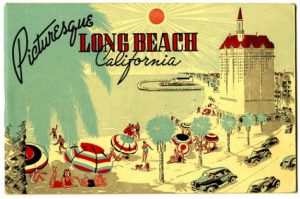
More often than not our work in genealogy and family history leads us to more than one proverbial brick wall. No matter how hard we try, or with what tenacity we might pursue that much needed fact, vital record, or even secondary source material, it all seems to no avail. While there is no panacea to cover all the brick walls we encounter, there just might be a way to refocus attention on the task at hand, i.e., research, by looking at unrelated people, places, or things – in a familiar place. Continue reading Common walls
‘Unbroken primogeniture’

An entertaining story about an American man claiming to be the rightful “King of Wales,” and a claimant as well to the throne of Great Britain, made the rounds last week after Allan V. Evans of Colorado posted a lengthy claim to the Welsh throne, noting the “injustice of history” that kept him from the British throne, to which he is heir by an “unbroken primogeniture line…”
Agnatic primogeniture dates back to early France and is known as Salic Law, where succession is obtained through kinship through the male line only. On a few occasions in France the king was succeeded by a distant male-line cousin, even when the deceased king had surviving daughters or sisters who had male children. Continue reading ‘Unbroken primogeniture’
‘You must be from Minnesota’
 Before I began working at NEHGS in November 2015, I had a job where I interacted with between thirty and fifty different people every day. One of those people was a linguist, who, upon hearing me speak, said, “You aren’t from here.” She was right. As I’ve mentioned in previous posts, I grew up in northern New Hampshire and moved to Massachusetts in 2011.
Before I began working at NEHGS in November 2015, I had a job where I interacted with between thirty and fifty different people every day. One of those people was a linguist, who, upon hearing me speak, said, “You aren’t from here.” She was right. As I’ve mentioned in previous posts, I grew up in northern New Hampshire and moved to Massachusetts in 2011.
I said to her, “No, I’m not from Massachusetts. I’m a transplant.”
Her answer, oddly enough, was, “You must be from Minnesota.” Continue reading ‘You must be from Minnesota’
Serendipity
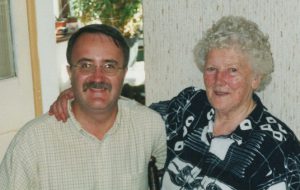
Inspired by the Persian fairy tale The Three Princes of Serendip, Horace Walpole gave us the word serendipity. The following three tales shine among my past treasures as extraordinary encounters that would have been lost to history had I not been in the right place at the right time.
In the fall of 1983, I drove to West Wareham, Massachusetts on a mission to find my great-grandfather’s grave. As I searched in vain for the stone, an elderly man who lived across the road from the cemetery spied my Vermont license plate and asked for whom I was searching. “Millard Morse, father of Emory,” I said. He retorted, “Who ARE you?” Continue reading Serendipity
Identifying a family bible
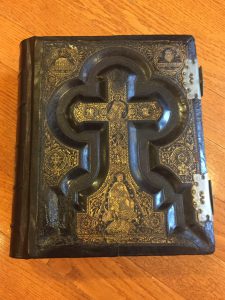
Growing up, I remember having two huge old family bibles in the house. They were in terrible condition with detached covers, loose pages, and other damage. My mother said they had been that way since she was a teenager. The bibles had been missing for some time but finally resurfaced a couple of years ago. I was able to find a book restorer who did an amazing job repairing the family heirlooms.
Both bibles were published in the late 1800s and had been kept by my great-grandmother, Helen (McKenna) Dickinson, who died when I was in college. One bible was clearly owned by Helen’s in-laws, John and Carrie (Luke) Dickinson. It contains birth, marriage and death records of both the Dickinsons and the Lukes. Continue reading Identifying a family bible
A Boston blueprint

I was recently enlisted to help my boyfriend clean out his mother’s basement; while not the most exciting of tasks, it actually led to an interesting historical discovery. Throughout this process we came across the usual repertoire of items that eventually made their way into a long-term storage area: unused kitchen appliances, tools and craft supplies, as well as old toys and keepsakes. However, in moving things around, one object in particular caught my attention. It was a large framed photo of a building. Continue reading A Boston blueprint
“Algonquinization?”
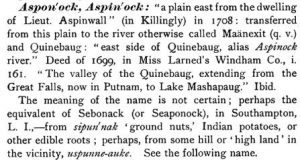 A friend from my hometown of Putnam, Connecticut posed a question on Facebook about what the word “Aspinock” literally means. Putnam was incorporated in 1855; in earlier years it had been known as Aspinock, but it was later named Putnam after General Israel Putnam of the Revolutionary War. Our local historical society remains the Aspinock Historical Society after this “original” town name. Continue reading “Algonquinization?”
A friend from my hometown of Putnam, Connecticut posed a question on Facebook about what the word “Aspinock” literally means. Putnam was incorporated in 1855; in earlier years it had been known as Aspinock, but it was later named Putnam after General Israel Putnam of the Revolutionary War. Our local historical society remains the Aspinock Historical Society after this “original” town name. Continue reading “Algonquinization?”
The house by the side of the road
 When my brother was little (long ago and not far away), he would lull himself to sleep by reciting the phrase on an antique cross-stitched sampler of a house which hung on the wall over his bed: “Let me live in a house by the side of the road and be a friend to man.” This simple sampler makes me think about how many things change yet remain the same in my neighborhood.
When my brother was little (long ago and not far away), he would lull himself to sleep by reciting the phrase on an antique cross-stitched sampler of a house which hung on the wall over his bed: “Let me live in a house by the side of the road and be a friend to man.” This simple sampler makes me think about how many things change yet remain the same in my neighborhood.
I have come to understand that my family history is intrinsically linked to the houses my ancestors built as well as the area in which they built them, two inseparable elements which complement each other, and which provide fodder for my “family stories.” Continue reading The house by the side of the road
Boston riches
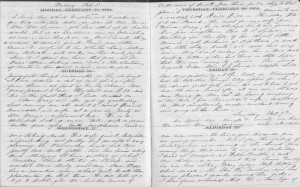
Certain diaries, and their authors, become short-hand for a time and place: Samuel Pepys’s diary of seventeenth-century London, for example, or Anne Frank’s diary of wartime Amsterdam. The diaries of Philip Hone and George Templeton Strong are often invoked to cover the first half of the nineteenth century in New York; for the Civil War years, readers turn to Mary Boykin (Miller) Chesnut’s Diary from Dixie (1905). Although rich in literary resources, Boston lacks such a diary for the mid-Victorian period. Boston men and women of the period wrote enduring works of fiction and non-fiction, but for this generation no Boston diarist has emerged to capture the tone of the times. Continue reading Boston riches